Free Guides
Email marketing is unique in its ability to reach both specific guests and broad audiences and still deliver relevant messages that deliver high ROI. This is especially true of resorts who often hard larger databases, more dynamic guests, and diverse reasons for visiting compared to a standalone hotel or other parts of the hospitality industry. But why is email marketing so good for resorts? What attributes give it so much power and how can resorts take full advantage of what email has to offer?
In this guide we’ll dig into exactly that by answering three key questions around the art and science of resort email marketing.
Does that sound like a plan? Let’s jump in.
To answer this question, we need to understand the fundamental technology behind email marketing platforms and how those differ from other marketing channels. Because while other channels like social media, PPC, etc. might look similar on the surface, the level of specificity in terms of who you send a message to, what you send them, and how they interact with each message is virtually untouchable by other channels. Let’s dig into each of those for a minute and explore the two-way personalization of email that creates so many powerful opportunities for resorts within email marketing.
First, while you can send emails to broad list of guests, don’t confuse emails your resort sends with messages your resort broadcasts on other digital marketing channels like Twitter or Instagram. Those channels are one to many – you create one message and multiple people see it. Email is truly one-to-one. While, yes, you can send the same message to everyone in an email list your resort generates, that’s only one way to use email, not the way to use email. Email will allow you to sent highly relevant emails to very specific target audiences in ways no other digital marketing channel can.
On that note, it’s important to realize that even if you send the same message to a large list of guests, because email is one-to-one, every email subscriber actually gets a different email behind the scenes. For example, each email will contain a tracking pixel that is totally unique to the specific recipient so your resort’s email marketing program can tell if they opened it. We’ll talk about that more in a second, but just understand that everything in an email is already customized for each subscriber before it gets delivered to that person.
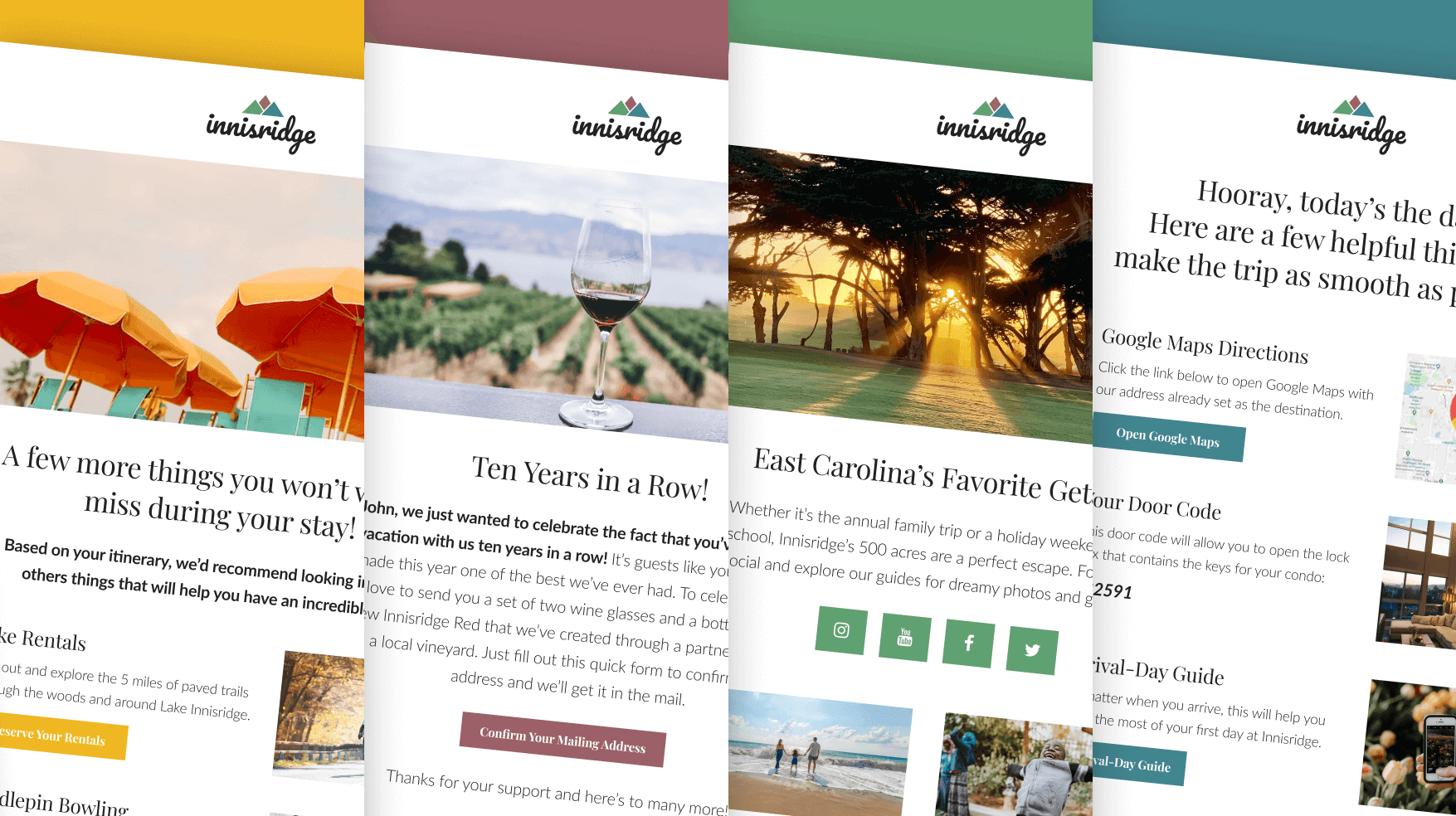
Resort email campaigns can cover everything from building loyalty to generating revenue.
This means that more sophisticated email marketing tools can allow your resort to customize the subject line, call to action, images, text, links, offers, and more to each guest based on the data you have about that guest. If your guest travels with their family, a resort email marketing tool can customize the contents to be more relevant to families while non-families in that campaign see other contents. It’s pretty powerful stuff especially when you compare it with the static, one-size-fits-all ads of social media advertising platforms.
But as we alluded to, that personalization goes two ways. Not only is there a unique tracking pixel for each recipient that, when loaded, feeds data back to the email marketing program telling them that janedoe@gmail.com opened your email marketing campaign, the same is true for links. And not just one link, but every link. Meaning that every link has a unique code attached to it that tells your resort’s email marketing tool exactly which link each guest clicked, when they clicked it, and how many times they clicked it. These metrics can be rolled up to aggregated open rates and click through rates, but this also opens up powerful avenues for tracking and revenue attribution that simply aren’t possible with other marketing channels. For example, you may have included a specific guest in a Facebook audience, but you can see when they saw the ad of if they did at all when that guest calls in an books. But with email you can see that guest not only got the email, they clicked through to the package details page 5 minutes before they called your call center.
All of these things combine to make email a perfect avenue to deliver highly relevant messages to specific guests based on data you have about that guest and be able to see exactly what happened after they received that email all the way through to them booking a vacation.
So, what do you need to get started? While, yes, you need things like email templates, assets, and such, resorts who want to get started with email marketing or take their email marketing up a notch primarily need two things.
Let’s dig into why you need both.
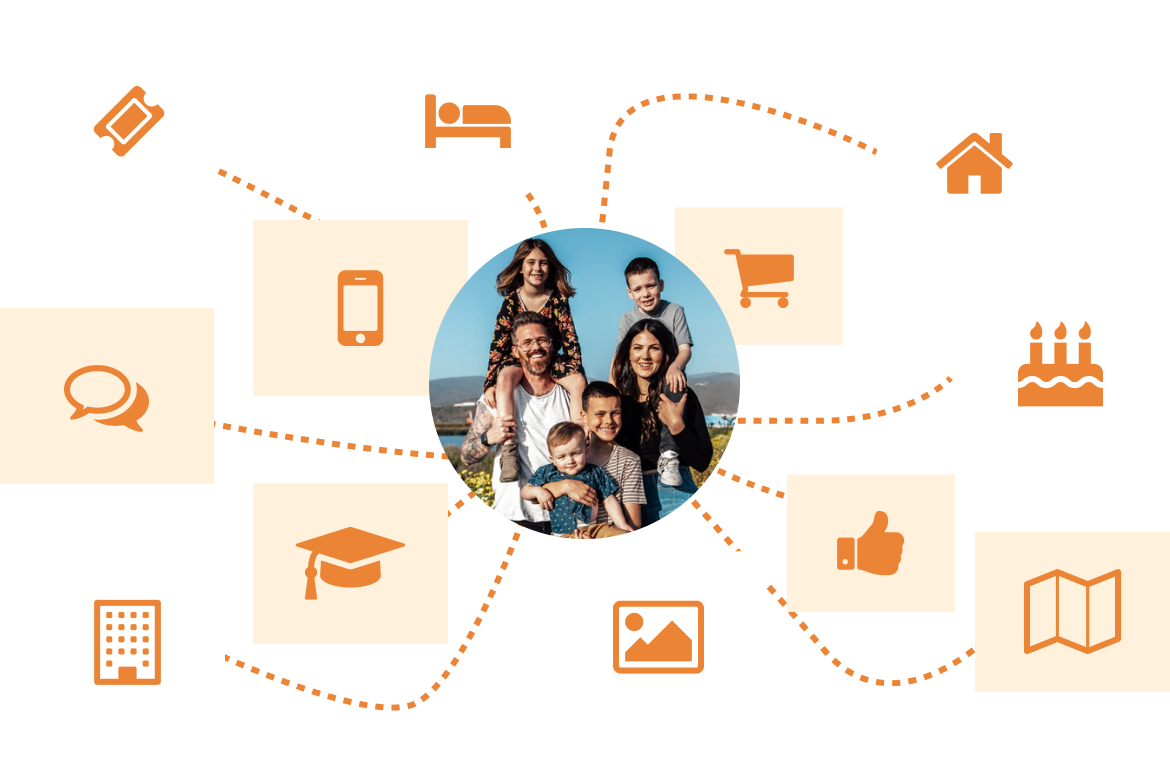
Unless your guest data in centralized, it will be very difficult to target emails to the right guests.
We’ve put a slash in there because modern resort CRMs will also act as CDPs and a CRM will give you many other tools a CDP cannot. The bottom line is that your resort has lots of guest data spread across lots of different places and you need to centralize it, clean it up, and then sync it to your email marketing platform. Your resort’s CRM tool will do this by establishing an integration with each system to regularly extract past guest data and new customers from each. This might be a property management system (PMS), point of sales system (POS), tee-sheet, survey tool, third-party data append, or other data source that contains useful information about your guest and their past or possible behavior.
The CRM will combine all of this data into clean guest profiles that combine duplicates, appends it with demographic data, and connect the dots between a household that booked lodging in the PMS and lift tickets in the POS so that you have a high-quality view of each guest. Your resort’s CRM will then sync all of this data into your email marketing tool along with all of these traits so you can target precise guests with specific messages. For example, if your midweek occupancy is soft but all you have left are single king rooms and typically 1-2 night stays, you could build a list of resort guests who have already purchased tee-times, live within a 3-4 hour drive radius, and don’t travel with kids. Or you could build an automation that automatically sends guests an offer for lodging and lessons if all they booked was lift tickets. Either way, this is only possible if all of your guest data is organized into accurate profiles and those profiles are synced to your email marketing platform.

A resort CRM will allow you to use data from all your systems when targeting and customizing email campaigns and other digital marketing campaigns.
Which leads us to the type of email marketing software you need. Some resorts will focus more on saving a few bucks up front, but the ROI you can generate with email and the conversion rate you get on email-generated traffic often scales exponentially with power of the tools you use to unlock that revenue for your resort. So rather than using a simple email marketing tool (often called an ESP) like ConstantContact or MailChimp, look for a tool that will allow you to take full advantage of deep information about each guest in the form of dynamic content and automation.
Dynamic content means that you can build unique blocks of content that are dynamically inserted into an email message based on what you know about that guest. For example, if your guest hasn’t bought a season pass yet, you could include a dynamic promotion block reminding them to do so. Automations are the other side that you need to be sure your ESP is ready to give you lots of options around. Resorts see guests book around very specific cycles and often have very large booking windows between the date of their transaction and the date they check in. These date-specific insights create the opportunity to set up powerful automations that help a guest arrive easily at your resort, have an incredible guest experience, gather data after they leave, and increase the likelihood they’ll return. But none of this is possible if your resort’s email marketing tool doesn’t have advanced automation features.
Another thing to consider if deliverability. If your emails aren’t hitting the inbox, it doesn’t matter how powerful your software is. Ensure that, no matter the price, your email software allows you to implement deliverability best practices and proper unsubscribe methods and sign up form strategies. Inbox issues aside, legal implications like CASL and GDPR should be evaluated as well. If an ESP fundamentally can’t even keep you in compliance with privacy laws in your markets, steer clear.
So you’ve got a good email marketing tool and your guest data is neatly syncing over to it. What does an email marketing strategy look like for resorts that takes full advantage of these tools you now have at your disposal to deliver high ROI, effective resort or hotel email marketing? When it comes to resort email marketing efforts, there are three buckets you can think about filling with campaigns.
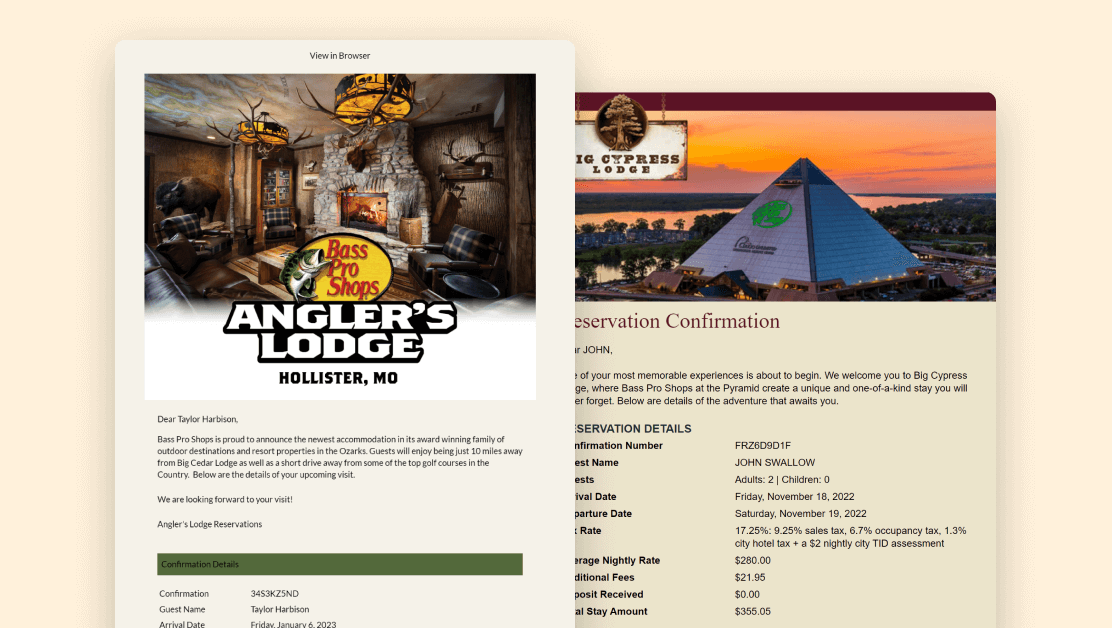
Customized confirmation emails like this one from Big Cedar can make every transaction an upsell opportunity.
Sometimes these are called “newsletters” or “e-blasts” but whatever the name, the idea is simple: It’s a message you manually brainstorm, create, and send to a larger group of guests at the same time. Instead of just thinking in terms of what you can include in a monthly newsletter, let your goals and current needs guide these campaigns. For example, if your season pass sales are lagging behind last year’s pace, create a pass promotion campaign and then build a targeted list of guests who haven’t renewed their pass or have never bought a bass but recently purchased tickets and send it only to them. Look for a cadence you can stick with whether that’s every few days or every few weeks and build these campaigns about the current needs and priorities your resort is facing. Be thoughtful about your email subject lines, contents, and special offers. While you should certainly do a/b testing on these campaigns, be sure you’re measuring attributed revenue more than vanity metrics like email open rates or click through rates.
Next are automated campaigns. These are email messages that are sent automatically based on guest behavior. Your resort’s email marketing program will allow you to combine an email campaign not with a specific list, but a specific trigger. For example, you might create a list of tips for traveling to your resort and tell your email program to send a pre-arrival campaign to guests at 9am the day they are set to check in at your resort. Or you could automate the cross-sell offer we mentioned earlier and have your email tool send a season pass promotion two days after someone buys a lift ticket or an offer for a bucket of balls the day after the book a tee time. One of the most simple marketing automation strategies is simply to send a welcome email when new customers enter your database. And why not automate feedback collection with a post-stay email with a link to your survey? Automations can be triggered by any guest data you have, including email behavior or website browsing behavior. If someone clicks on an email and visits your spa page, you could automate a follow up message the next day for all guests who visited the spa page but didn’t end up booking.
Analyze the customer journey and you’re sure to find email campaigns that go far beyond traditional email newsletters and into the realm of powerful marketing automations that generate upsells, guest satisfaction, and loyalty. Some automations can even replace your traditional loyalty program with low-overhead loyalty recognition campaigns that drive very similar behavior.
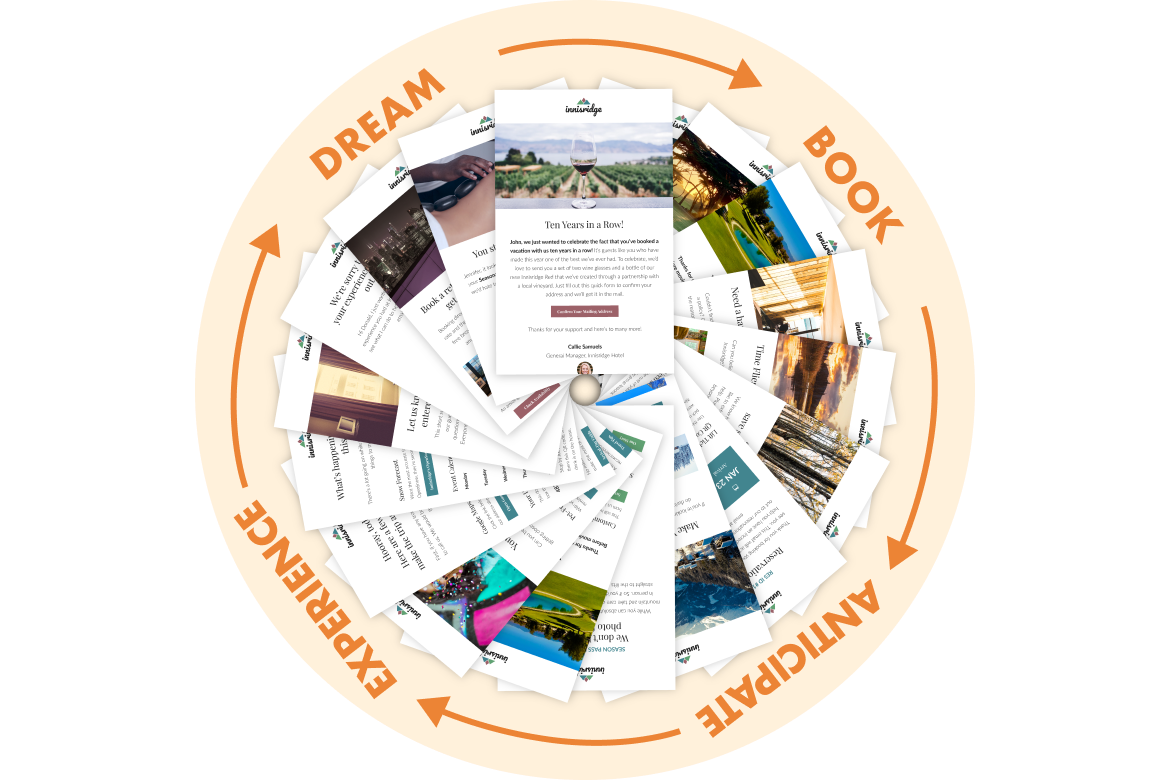
Resort email marketing automation can reach guests at every stage of the travel cycle.
Finally are transactional emails. These are the confirmation emails, cancellation emails, and itinerary change emails that so many guests rely on. While your booking engine may have a default email they already create, you may want to look into a resort CRM that can automate these with your email marketing tool. Not only will you have all of your emails being sent through the same system, but you’ll also have access to tools that allow your team to quickly resend any of these emails to your guests. A resort CRM with re-send capabilities can save your team hundreds if not thousands of hours of work each year.
So while transactional emails may not always fall into the same bucket as marketing emails, they’re absolutely something you should think through as you get your resort going with more advanced email marketing efforts.
Email marketing is a powerful tool for resorts, but why? And how does it compare to other digital marketing channels like social media, OTT, or paid search? To understand why email works so well, we need to understand the nuts and bolts of email and how those compare to these other digital marketing platforms.
Email marketing is 1-to-1 on a level that other platforms simply can’t deliver. While you may be required to have 1,000 or more guests in an audience to target on Facebook or Google, even if you go that small you still have to deliver the same message to every person. Email lets you send one specific email with one specific message to one specific person.
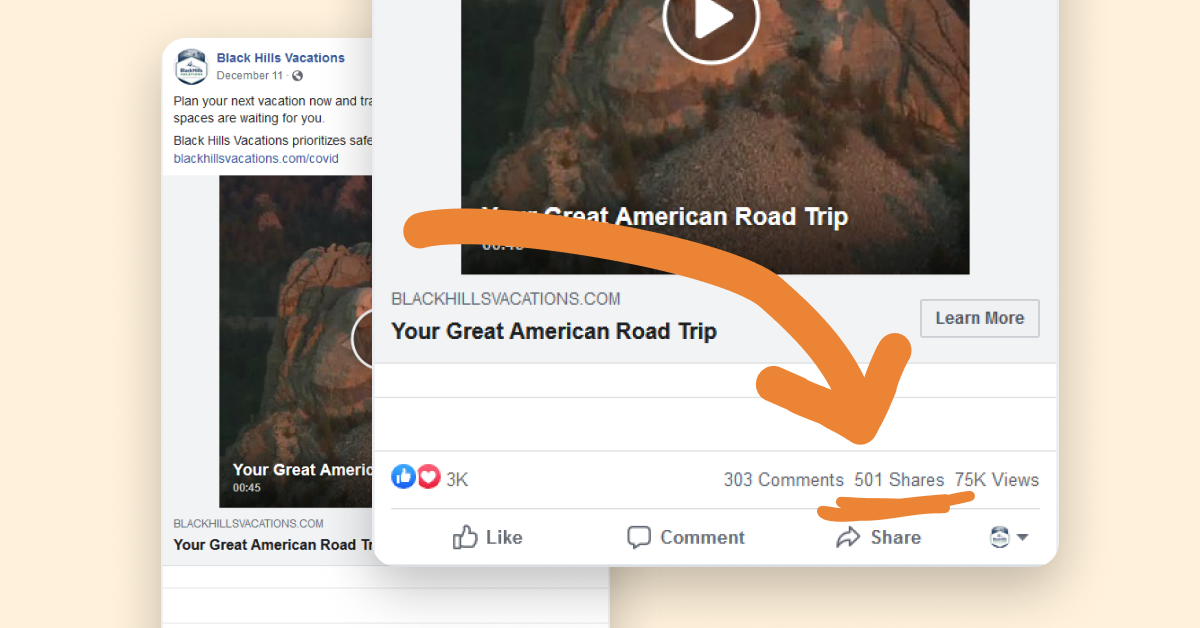
Even the best Facebook campaigns we’ve helped our users with can’t touch the performance of email marketing.
Even an email that is sent to many guests will have a unique code attached to every link in the email that are tied to the exact recipient it’s being sent to. It will also have a small tracking pixel that’s unique to every recipient. Other digital marketing channels will only show performance on the aggregate in terms of click rate or conversion rate. But because email is so specific to each person, you can see exactly who opened, what they clicked, and tie that back to what they ordered with incredible accuracy.
Compared to other channels where a click may cost $2-$5 or more, if you send 10,000 emails and even get a 1% click rate (which is low for email), the cost of sending those 10,000 emails translates to a cost per click of around $0.25 – $0.50. Even more, the conversion rate on email traffic is typically many times that of social media or paid channels, so resorts often generate dozens if not hundreds of dollars in revenue from every click on average.
Digital marketing talking heads have been predicting the downfall of email for decades. Yet email doesn’t just stick around, it thrives. And with such incredible performance versus other digital channels, resorts have seen an increase in investment, performance, and strategy around this channel in recent years.
Want to take your resort’s email marketing to the next level? Check out Inntopia Marketing Cloud.